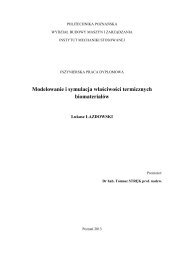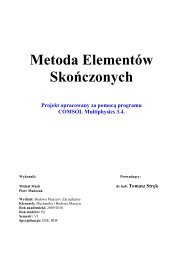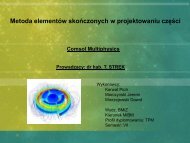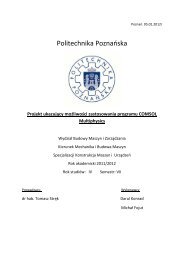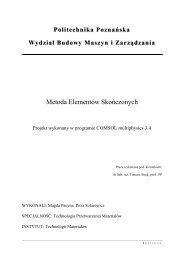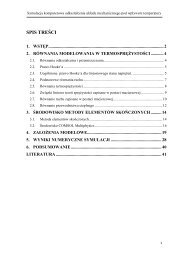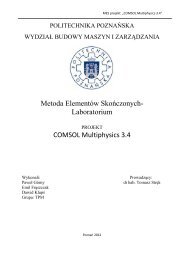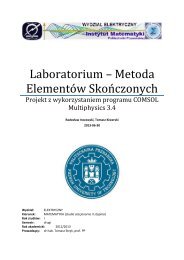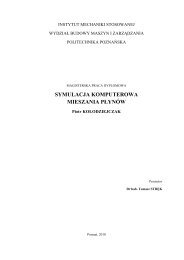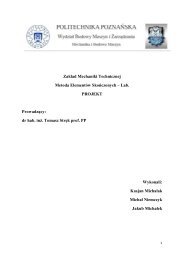Lithium-Ion Battery Simulation for Greener Ford Vehicles
Lithium-Ion Battery Simulation for Greener Ford Vehicles
Lithium-Ion Battery Simulation for Greener Ford Vehicles
Create successful ePaper yourself
Turn your PDF publications into a flip-book with our unique Google optimized e-Paper software.
MEDICAL<br />
HCL TECHNOLOGIES, CHENNAI, INDIA<br />
Optimal Wound Treatment Thanks to Modeling<br />
BY CHANDRAMOHAN ELAMVAZHUDHI AND MOKAN MARIMUTHU, HCL TECHNOLOGIES LTD.<br />
Treating and dressing wounds is often<br />
straight<strong>for</strong>ward because these are<br />
easily accessible, but that’s not always<br />
the case. One good example is surgery<br />
<strong>for</strong> sinusitis, which cannot always be<br />
cured with medication alone. Following<br />
surgery, however, the wound must be<br />
treated by spraying the nasal cavities<br />
with a special <strong>for</strong>mulation that keeps the<br />
surgical wounds moist, disinfects them<br />
and provides protection against seepage<br />
of internal fluids to ensure rapid healing.<br />
However, getting a uni<strong>for</strong>m coating<br />
of the right amount in all the right spots<br />
is not an easy task. To find an answer to<br />
this problem, a medical company turned<br />
to HCL Technologies — Engineering Services<br />
Group in Chennai, India, to design<br />
a sprayer that would meet the above requirements<br />
while using the least amount<br />
of expensive medication.<br />
Trans<strong>for</strong>mational Outsourcing<br />
HCL Technologies is a leading global<br />
IT services company that focuses on<br />
“Trans<strong>for</strong>mational outsourcing”. With<br />
consolidated revenues of $3.1 Billion, it<br />
has offices in 29 countries and provides<br />
services in vertical markets including<br />
Financial services, Telecom, Media,<br />
Retail, E&U, Public sector, Medical<br />
devices and others. HCL Technologies —<br />
Engineering Services is one of the service<br />
line and Mechanical Engineering is part<br />
of this service wing. CAE centre of excellence<br />
is a core team <strong>for</strong> product development<br />
under Mechanical Engineering.<br />
In this application, the physician inserts<br />
the sprayer nozzle into the patient’s<br />
nostrils one at a time. The sprayer mixes<br />
four phases of medicinal fluids that react<br />
to <strong>for</strong>m a single phase. This is biodegradable<br />
coating is sprayed through the<br />
nozzle into the sinus cavity with pressurized<br />
air. The design we worked on was a<br />
multi-hole sprayer with the goal of optimizing<br />
the mass flow rate and angle of<br />
spray at each hole to cover the desired<br />
area within the nasal cavity. Design optimization<br />
was carried out considering different<br />
configurations of the holes where<br />
the model inputs were the final fluid’s<br />
dynamic viscosity as well as the inlet<br />
and outlet pressures.<br />
This application differs from other nozzle<br />
designs in that the number of holes,<br />
their dimensions and locations are highly<br />
sensitive parameters; this is unlike many<br />
industrial applications where these parameters<br />
don’t significantly affect system<br />
per<strong>for</strong>mance. Here, too, we wanted<br />
“ Our experience shows that the cost of prototype<br />
and testing drops by a third when we use COMSOL.”<br />
a<br />
b<br />
Fig. 1. A quarter symmetry of the actual nozzle<br />
geometry with a typical placement of holes modeled<br />
in COMSOL (right)<br />
to increase the flow rate, but arbitrarily<br />
adding holes would not only lead to poor<br />
spray coverage but it would also waste expensive<br />
medication.<br />
There was no logical way to determine<br />
the best hole pattern. Previously we would<br />
have had to go to a prototype shop, have<br />
perhaps 40 to 50 prototypes fabricated<br />
and examine them in detail. Instead, we<br />
turned to DoE (Design of Experiment) approach<br />
through Minitab software and then<br />
COMSOL Multiphysics to do this study<br />
numerically. Our experience shows that<br />
the cost of prototype and testing drops by<br />
a third with the use of COMSOL, and the<br />
time needed to conduct a study of a prototype<br />
takes only a third as long.<br />
Sensitivity Analysis,<br />
Then <strong>Simulation</strong><br />
The process follows these stages. First<br />
we conduct a DoE sensitivity analysis using<br />
a Box-Behnken study implemented<br />
with Minitab software. This helps us to<br />
identify the critical factors influencing<br />
flow and determine the possible number<br />
of holes and their placement. We place restrictions<br />
on these two parameters based<br />
purely on engineering experience. The DoE<br />
analysis helps us reduce the infinite number<br />
of possible combinations to a handful<br />
Fig. 2. Mass flow rate superimposed with velocity streamlines (Fig. 2a) and varying viscosity<br />
across the Nozzle as a (Fig. 2b) superimposed with arrow velocity from one 5-hole configuration.<br />
4 0 // C O M S O L N E W S 2 0 1 1<br />
➮<br />
Cov ToC + – A<br />
➭<br />
40-41 CN HCL 2011.indd 40 5/16/11 9:27 AM



